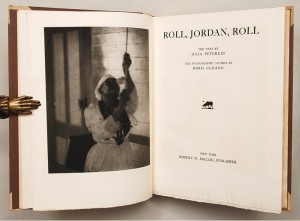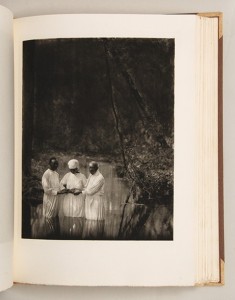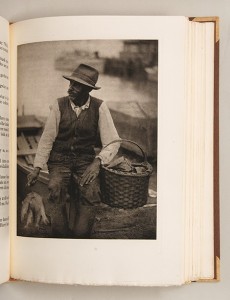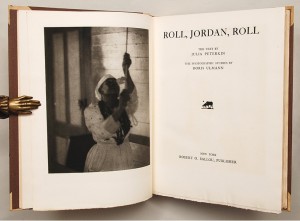At the height of the Great Depression, photographer Doris Ulmann and writer Julia Peterkin traveled to South Carolina to photograph the descendants of freed slaves. The resultant stunning volume was printed with 90 photographs, entitled Roll, Jordan, Roll.

It is without a doubt one of the most beautiful collections of photography produced in the 20th Century.
Ulmann’s extraordinary talent for portrait photography was honed in Park Avenue, where she spent time producing portraits of celebrities after training with Clarence White. She then spent time photographing Mennonite and Shaker communities, and in 1927 produced a beautiful series of Appalachian portraits, published in book form posthumously.
Her work is widely collected, and the images found in Roll, Jordan, Roll – accompanied by Peterkin’s text – present a dramatic and ethereal picture of life on a South Carolina planation.
The work is a first edition, printed in a limited issue of 350 copies on large paper. Signed by both Peterkin and Ulmann, it contains 90 images, rather than the 70 presented in the trade issue. The paper is handmade and the images are sharp and striking, depicting scenes from a world that appears to have never industrialised. As a photographer, Ulmann artfully borders the Pictorialist and Modernist traditions.
The book appears to have not been distributed by more usual commercial means, and seems much scarcer than 350 copies. Additionally, some of those that have survived have suffered from water damage; many have speculated that Ulmann’s storeroom flooded at some point.

Peterkin grew up on the coast of South Carolina, the child of a wealthy white family with black servants. She then married the heir of the Lang Syne, the most prosperous plantation in Carolina, which meant close observation of the workers and the opportunity to photograph them. There is subsequently a notable division: the photographer and writer are observing through the lens of outsiders, with all the complexity and naivety which comes with it.

This divide serves to further demonstrate how far notions of racial equality still had to come, despite the abolishment of slavery having taken place 65 years previously. The portraits taken by Ulmann are an important document not only of the lives of the African American plantation workers, but the perceptions their white employers had of them.
Ulmann’s portraits have a penetrative quality, impressing upon the reader the individuality of each of her subjects, while Peterkin’s text provides a necessary historical context.
The book is available here.





